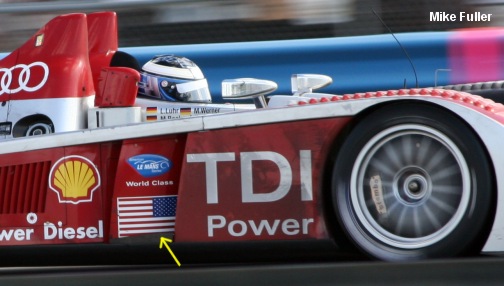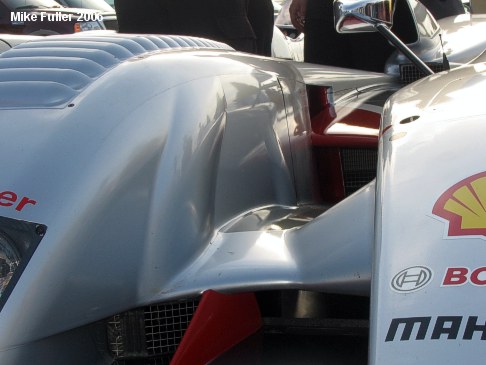 |
It is amazing how low the upper A-arm mounts to the tub, the angle bit inboard being the pushrod. The profile of the fender itself is very similar to the R8 when viewed from the side. Note the bulges on the fender for tire clearance. The bulges are a somewhat perplexing detail and seem to suggest a late change in tire diameter. We know from the press material that this is an area of difference to the R8, though incorrectly stated as a difference in width. It is actually a difference in diameter--650 mm diameter for the R8, 680 mm diameter for the R10's fronts. In actuality the R8's fronts are wider comparatively, 13.5" vs. the R10's 13.0", though the R10's are taller as noted. |
| The
appearance of a parting line also
lends credence to this thought (a later change in front tire dimension
for R10). It would be easier to modify a section of the
existing
fender pattern than resurface (re-CAD) and re-cut the entire
pattern.
And the entire fender would have to be resurfaced in order to integrate
the bulges into the existing surfaces.
Certainly the initial thought is that the fender was reduced in size as much as possible as viewed from the front in order to reduce it's frontal projection. But surely this was being done anyway? Additionally, in frontal projection the bulges are still viewable making any frontal area reduction academic. |
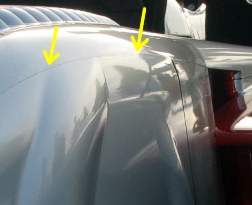 |
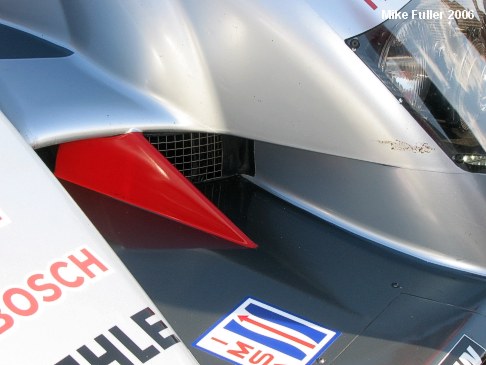 The
brake ducts are that in name only. The single seater nature
of the
brake cooling is very evident when the bodywork comes off (below).
The
brake ducts are that in name only. The single seater nature
of the
brake cooling is very evident when the bodywork comes off (below).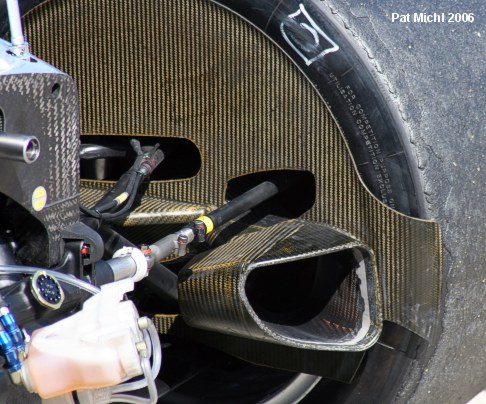 The
air intake for the brakes matches up to the duct in the bodywork (with
appropriate room for wheel movement). The brake duct backing
plate
actually overlaps the tire (not residing within the circumference of
the
wheel) and has an extension where the duct proper is. This
extension
may act to reduce the amount of foreign object ingestion as the wheel
travels
throughout its steering lock.
The
air intake for the brakes matches up to the duct in the bodywork (with
appropriate room for wheel movement). The brake duct backing
plate
actually overlaps the tire (not residing within the circumference of
the
wheel) and has an extension where the duct proper is. This
extension
may act to reduce the amount of foreign object ingestion as the wheel
travels
throughout its steering lock.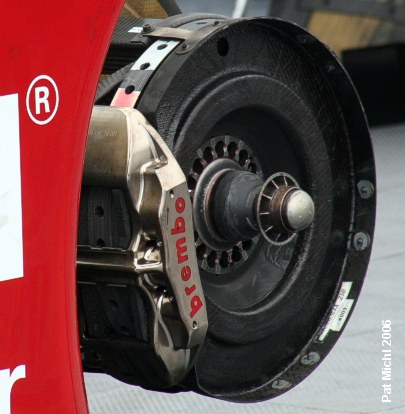 The
brakes also have an outboard backing plate that completely masks the
disc.
The entire brake ducting system is driven by desires to improve brake
cooling
as well as to eke out aerodynamic gains through reducing drag and
gaining
downforce. Contemporary high temperature resin systems make
this
a reality. The shielding is so close in proximity to the very
hot
carbon brake that in order to survive (much less through an endurance
race
length of 12 to 24 hours--we're not talking Grand Prix race lengths!)
it
must be made of resilient stuff!
The
brakes also have an outboard backing plate that completely masks the
disc.
The entire brake ducting system is driven by desires to improve brake
cooling
as well as to eke out aerodynamic gains through reducing drag and
gaining
downforce. Contemporary high temperature resin systems make
this
a reality. The shielding is so close in proximity to the very
hot
carbon brake that in order to survive (much less through an endurance
race
length of 12 to 24 hours--we're not talking Grand Prix race lengths!)
it
must be made of resilient stuff!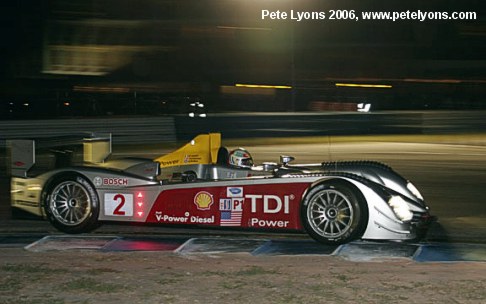 Though
the result of the shrouded brake discs is that brake glow is no longer
visible on the R10.
Though
the result of the shrouded brake discs is that brake glow is no longer
visible on the R10.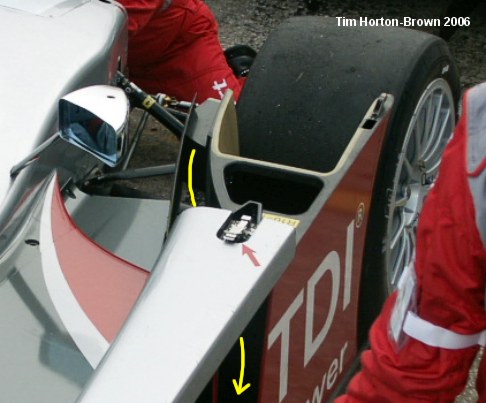 As
on the Audi R8, the R10's outboard plan view fender profile is off set
from the inboard surface creating a channel which allows for airflow
extraction
from the wheel well.
As
on the Audi R8, the R10's outboard plan view fender profile is off set
from the inboard surface creating a channel which allows for airflow
extraction
from the wheel well.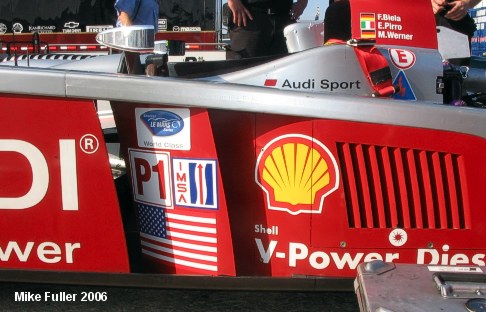 The
wheel well exit panel forms a rules compliance function masking
mechanical
parts of the car as seen from the side.
The
wheel well exit panel forms a rules compliance function masking
mechanical
parts of the car as seen from the side.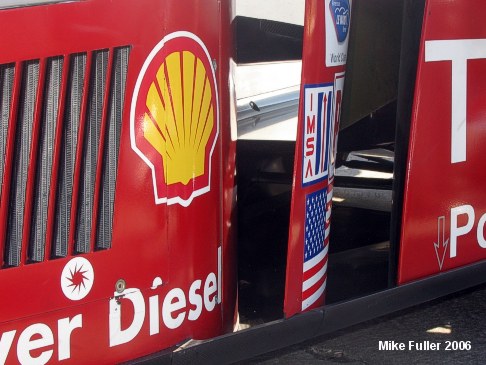 Looking
up into the diffuser/wheel well exit. In the forward slot you
can
see up into the wheel well proper (yellow Kevlar wheel well lining),
aft
you can just see the trailing edge of the diffuser. From this
vantage
point you can also see the lower A-arm of the front suspension and its
forward and rearward pickups on the tub.
Looking
up into the diffuser/wheel well exit. In the forward slot you
can
see up into the wheel well proper (yellow Kevlar wheel well lining),
aft
you can just see the trailing edge of the diffuser. From this
vantage
point you can also see the lower A-arm of the front suspension and its
forward and rearward pickups on the tub.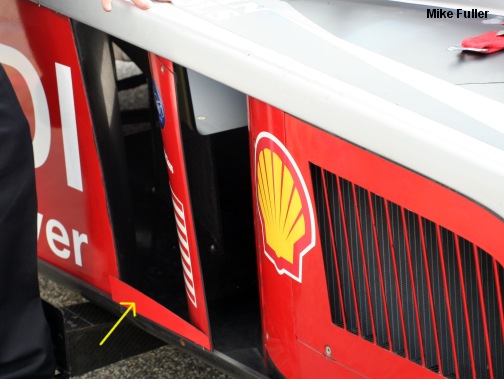 Towards
the end of 2007 a red vertical lip appeared in the exit of the forward
front diffuser exit. Subsequently this was painted black
(below,
Sebring '08) making it a little harder to see. As to its
function,
best speculation is that it further helps extract air from the front
fender
valley/diffuser. And this makes sense if you think of the lip
as
a gurney creating a low pressure area on its outboard surface.
Towards
the end of 2007 a red vertical lip appeared in the exit of the forward
front diffuser exit. Subsequently this was painted black
(below,
Sebring '08) making it a little harder to see. As to its
function,
best speculation is that it further helps extract air from the front
fender
valley/diffuser. And this makes sense if you think of the lip
as
a gurney creating a low pressure area on its outboard surface. 